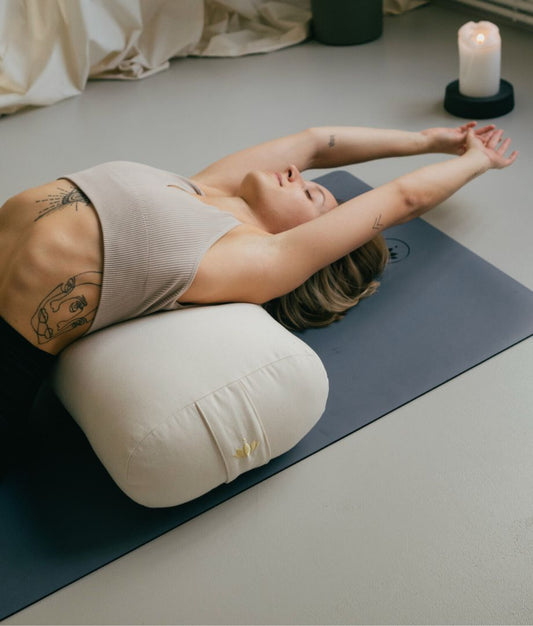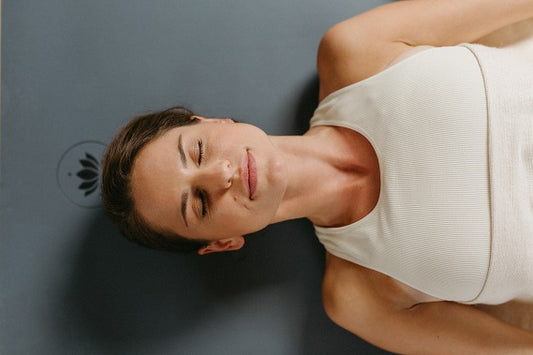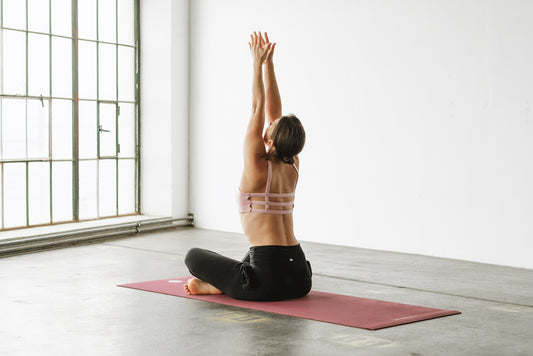
Set-Offers
Save when you buy a set
Shopping cart
Your shopping basket is empty
Yoga

Meditation
Bundles

| Meditation
Numerous types of yoga are now known and popular in Germany - we have already reported on many of them in more detail. But the term "Yoga Nidra" is probably unknown to many people interested in yoga. No wonder: in the west, many people combine yoga with practicing asanas. In a classic yoga class, there is often a short meditative element, sometimes also one or the other yogic breathing exercise. Yoga Nidra is slightly different: the discipline of yoga focuses on a state between meditation and sleep.

Translated, the Sanskrit term "Yoga-Nidra" roughly means "Yoga of sleep". It is not about asanas, breathing exercises or meditation, but about reaching a state between sleep and meditation. Most of the time, the practitioners lie or sit. This yoga technique comes from the tantric tradition.
The aim of deep relaxation is to create access to deeper layers of consciousness. This should make it possible to completely relax mentally, emotionally and physically. The teachings of Swami Satyananda Saraswati can be identified as an important influence.
Swami Saraswati (1923-2009) was the founder of the "Bihar School of Yoga" in 1964. This dealt with the research of yogic traditions.
According to Saraswati, six major yoga traditions have been groundbreaking: Hatha Yoga, Raja Yoga and Kriya Yoga represent the outer yoga paths. They deal primarily with physical and mental exercises. The goal is the dissolution of our conditioning and personality development. Swami Saraswati sees Karma Yoga, Bhakti Yoga and Jnana Yoga as inner yoga paths. They strive for a more positive and creative lifestyle.
The relaxation method of Nidra Yoga was derived from Raja Yoga. The yoga method influenced by Saraswati offers itself as a stress relief exercise. It could be integrated into the treatment of patients with burnout. In addition, this method of deep relaxation as an accompanying therapy could contribute to the healing of diseases.
The teachings of Swami Satyananda Saraswati were the basis for the development of Yoga Nidra. Satyananda referred to old tantric sources. His goal was to give stressed people a remedy against the increasing sensory overload through deep relaxation. The Yoga Nidra students should learn to put themselves in a receptive state of mind without any effort. He saw this as a prerequisite for deep relaxation and a focus on the inside.
In Yoga Nidra, the student first assumes a lying or relaxed sitting position. The lying position is called "Shavasana", those who prefer to sit can do the cross-legged sit, the heel sit or an upright position on a chair.
In this position, the practitioner initially consciously concentrates on the perception of his or her environment. Then the focus shifts to the interior. If the practitioner practices alone, he now deals with an affirmation. The content of this is a goal in life that the practitioner wants to achieve.
Then the reclining or sitting person embarks on a mental journey into the inside of his body. He consciously perceives his body parts, his organs and the ground he is lying on. Through this silent journey, the body can let go of all tension and cramps.
He consciously perceives feelings such as joy, worrying brooding or physical pain. He feels his breathing. He perceives their passage through the respiratory organs. He consciously feels cold or warmth, tension or relaxation. The practitioner becomes aware of his sensations and feelings during the exercise. Meanwhile, the brain strives to create a harmonious balance between the inside and the outside. The brain's aspirations are directed towards well-being.
At the end of the exercise, the affirmation is repeated. Practitioners consciously bring themselves back into the here and now. The sacred "OM" is repeated three times at the end of the lying meditation.
One of the goals of Nidra Yoga is to enable the practitioner to have a different perception of himself. Swami Satyananda Saraswati recognized early on that we are living in an increasingly hectic and overstimulated time. Many people get caught up in everything that happens around them. They are subject to external stimuli. They enter a sea of media floods. They lose their center through the demands of modernity.
With the exercises of Nidra Yoga, practitioners can withdraw into their inner self at any time. If body and mind are in a meditative, relaxed and receptive state, the practitioner can recover from daily stress. The person concerned can focus more on their own goals. He's better at keeping everything that's stressing him out. The practice of Nidra Yoga enables him to go to work refreshed and focused. He does not lose sight of his own goals through the internalized affirmation.
Nidra Yoga is considered to be Swami Saraswati's most important contribution to yoga, alongside his research work on yoga traditions. His yoga practice, borrowed from tantra, is seen as a "dynamic form of sleeping". The relaxed state that can be achieved with this creates an access to the inside. The stressed person perceives his feelings and his physical tension. He becomes aware of his mental, emotional and spiritual needs.
Deep relaxation anytime and anywhere sounds very good as a goal. Of course, if you are just starting out with Yoga Nidra, you have a long way to go before you can fully relax.
Luckily, Yoga Nidra also has a lot of positive effects that practitioners can usually feel after just a few sessions, for example:
Regular exercise reduces the release of stress hormones. The immune system can work more stably.
That's why Yoga Nidra is even said to support the healing of various diseases. All in all, a yoga direction that you should try once. :)
Honestly, when I first heard about Yoga Nidra myself, my first reaction was, "Should I really pay money to 'lay around' for an hour?" - so I personally started with the exercises at home and oriented myself to instructions from the net.
As with any other yoga discipline, my personal conclusion is: It can also be done without a teacher, but it may work better with the right teacher.
If you want to practice at home first, I would like to give you a few tips:
Have fun on the mat!

In our fast-moving world, we are constantly busy: we plan, analyze and are usually somewhere else mentally. For many, this is the only rhythm they...
Continue reading
The 5 Yamas and 5 Niyamas of Patanjali's "Yoga Sutra" represent the first and second stage of the eight-part path and serve to treat oneself and t...
Continue reading
There are no comments yet. Be the first to leave a comment!